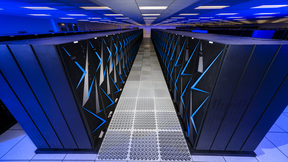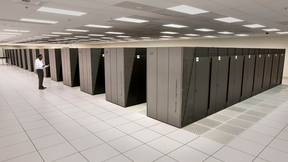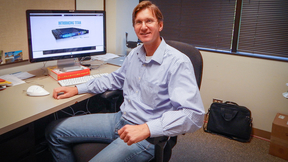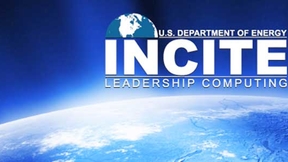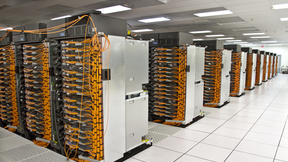Back
The Department of Energy’s National Nuclear Security Administration (NNSA), Lawrence Livermore National Laboratory (LLNL) and its industry partners today officially unveiled Sierra, one of the world’s fastest supercomputers, at a dedication ceremony to celebrate the system’s completion. Sierra will serve the NNSA’s three nuclear security laboratories, LLNL, Sandia National…
Lawrence Livermore National Laboratory’s (LLNL) next-generation supercomputer, Sierra, is the third-fastest computing system in the world, according to the TOP500 list announced today at the International Supercomputing Conference in Frankfurt, Germany. Expected to be fully operational this fall, Sierra will support the National Nuclear Security Administration’s (NNSA)…
New Orleans, Louisiana. Nov. 18, 2014 -- Lawrence Livermore National Laboratory scientists’ search for new ways to solve large complex national security problems led to the top ranking on Graph 500 and new techniques for solving large graph problems on small high performance computing (HPC) systems, all the way down to a single server. "To fulfill our missions in national…
LIVERMORE, California - New medications created by pharmaceutical companies have helped millions of Americans alleviate pain and suffering from their medical conditions. However, the drug creation process often misses many side effects that kill at least 100,000 patients a year, according to the journal Nature. Lawrence Livermore National Laboratory researchers have…
A team of researchers led by Andreas Kemp has received a 2014 Leadership Computing Challenge award from the DOE Office of Advanced Scientific Computing Research (ASCR) to further pursue the study of short-pulse laser interactions with solid density plasmas using supercomputer simulations.The research project entitled "Laser-driven relativistic electron beam filamentation…
The Lab has joined forces with two other national labs to deliver next generation supercomputers able to perform up to 200 peak petaflops (quadrillions of floating point operations per second), about 10 times faster than today's most powerful high performance computing (HPC) systems. The Collaboration of Oak Ridge, Argonne and Livermore (CORAL) national labs will produce…
Research from the Lab'sFrederic Perez, Andreas Kemp, Laurent Divol, Cliff Chen and Prav Patel is featured on the cover of the Dec. 13 2013 issue of Physical Review Letters. For several decades, physicists have used lasers of very high power, such as at LLNL's Jupiter Laser Facility, to create extreme states of matter. By focusing such lasers to a beam as narrow as a few…
LIVERMORE, Calif. - As part of the Department of Energy's Innovative and Novel Computational Impact on Theory and Experiment (INCITE) program, 13 Lawrence Livermore National Laboratory (LLNL) researchers have been awarded more than a billion core hours on two of America's fastest supercomputers dedicated to open science --Mira, an IBM Blue Gene/Q system located at Argonne…
WHAT: Lawrence Livermore National Laboratory will present its groundbreaking supercomputer simulation capability to realistically and rapidly model a beating human heart to better understand fatal disease. Developed in collaboration with IBM on one of the world's fastest supercomputers at Lawrence Livermore, such powerful simulations could have considerable impact on the…
Supercomputer at Lawrence Livermore National Lab passes 16 petaflopsWASHINGTON, D.C. - The National Nuclear Security Administration (NNSA) today announced that a supercomputer called Sequoia at Lawrence Livermore National Laboratory (LLNL) was ranked the world's most powerful computing system.Clocking in at 16.32 sustained petaflops (quadrillion floating point operations…
The Lab's Sequoia supercomputer is the world's fastest high performance computing system on the international ranking announced earlier today at the International Supercomputing Conference (ISC) in Hamburg, Germany. Clocking in at 16.32 sustained petaflops (quadrillion floating point operations per second), Sequoia earned the number one ranking on the industry standard…

